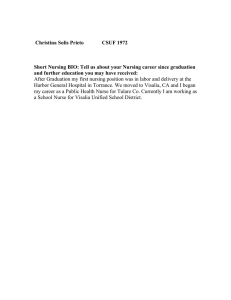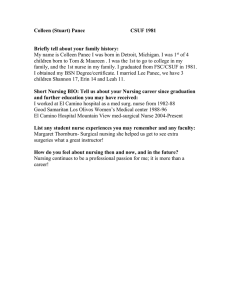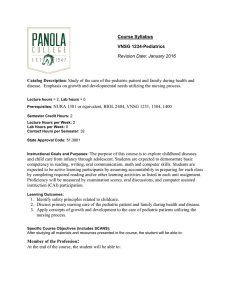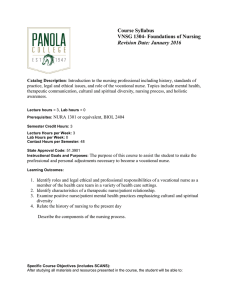Course Syllabus VNSG 1219-Leadership and Professional Development Catalog Description
advertisement
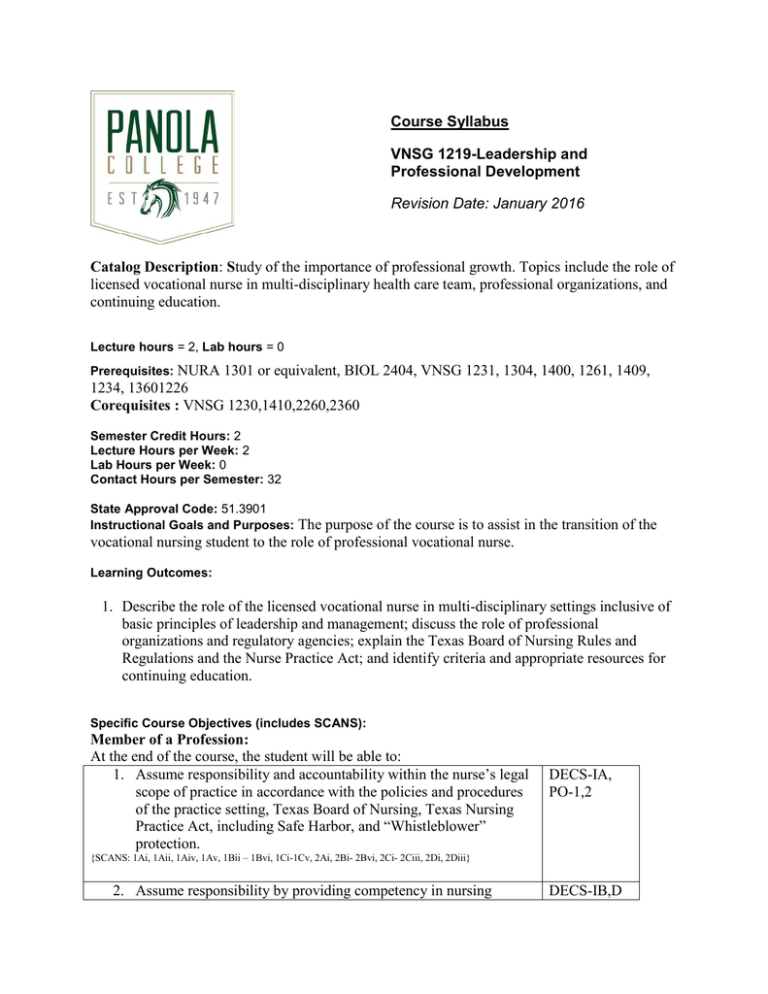
Course Syllabus
VNSG 1219-Leadership and
Professional Development
Revision Date: January 2016
Catalog Description: Study of the importance of professional growth. Topics include the role of
licensed vocational nurse in multi-disciplinary health care team, professional organizations, and
continuing education.
Lecture hours = 2, Lab hours = 0
Prerequisites: NURA
1301 or equivalent, BIOL 2404, VNSG 1231, 1304, 1400, 1261, 1409,
1234, 13601226
Corequisites : VNSG 1230,1410,2260,2360
Semester Credit Hours: 2
Lecture Hours per Week: 2
Lab Hours per Week: 0
Contact Hours per Semester: 32
State Approval Code: 51.3901
Instructional Goals and Purposes:
The purpose of the course is to assist in the transition of the
vocational nursing student to the role of professional vocational nurse.
Learning Outcomes:
1. Describe the role of the licensed vocational nurse in multi-disciplinary settings inclusive of
basic principles of leadership and management; discuss the role of professional
organizations and regulatory agencies; explain the Texas Board of Nursing Rules and
Regulations and the Nurse Practice Act; and identify criteria and appropriate resources for
continuing education.
Specific Course Objectives (includes SCANS):
Member of a Profession:
At the end of the course, the student will be able to:
1. Assume responsibility and accountability within the nurse’s legal
scope of practice in accordance with the policies and procedures
of the practice setting, Texas Board of Nursing, Texas Nursing
Practice Act, including Safe Harbor, and “Whistleblower”
protection.
DECS-IA,
PO-1,2
{SCANS: 1Ai, 1Aii, 1Aiv, 1Av, 1Bii – 1Bvi, 1Ci-1Cv, 2Ai, 2Bi- 2Bvi, 2Ci- 2Ciii, 2Di, 2Diii}
2. Assume responsibility by providing competency in nursing
DECS-IB,D
practice through continuing education and principles of quality
improvement.
PO-1,2
{SCANS: 1Ai, 1Aii, 1Aiv, 1Av, 1Bii – 1Bvi, 1Ci-1Cv, 2Ai, 2Bi- 2Bvi, 2Ci- 2Ciii, 2Di, 2Diii}
3. Compare organizational frameworks of various health care
settings, including chain of command.
DECS-IA
{SCANS: 1Ai, 1Aii, 1Aiv, 1Av, 1Bii – 1Bvi, 1Ci-1Cv, 2Ai, 2Bi- 2Bvi, 2Ci- 2Ciii, 2Di, 2Diii}
4. Discuss nursing professionalism including continuing
competency, professional development, communication
techniques, appearance, and values.
DECS-ID
PO-2
{SCANS: 1Ai, 1Aii, 1Aiv, 1Av, 1Bii – 1Bvi, 1Ci-1Cv, 2Ai, 2Bi- 2Bvi, 2Ci- 2Ciii, 2Di, 2Diii}
5. Use self-evaluation, peer evaluation, reflection, and feedback to
improve practice.
{SCANS: 1Ai, 1Aii, 1Aiv, 1Av, 1Bii – 1Bvi, 1Ci-1Cv, 2Ai, 2Bi- 2Bvi, 2Ci- 2Ciii, 2Di, 2Diii
Provider of Patient –Centered Care
At the end of the course, the student will be able to:
6. Plan nursing care using clinical reasoning and evidence based
policies to provide safe care to patients with predictable health
care needs.
DECS-ID
PO-2
DECS-IIA,D
PO-3,4
{SCANS: 1Ai, 1Aii, 1Aiv, 1Av, 1Bii – 1Bvi, 1Ci-1Cv, 2Ai, 2Bi- 2Bvi, 2Ci- 2Ciii, 2Di, 2Diii}
7. Use self-directed critical thinking approach to analyze data and
information from multiple sources as a basis for decision-making
in nursing.
DECS-IIA,B,C,
PO-5
{SCANS: 1Ai, 1Aii, 1Aiv, 1Av, 1Bii – 1Bvi, 1Ci-1Cv, 2Ai, 2Bi- 2Bvi, 2Ci- 2Ciii, 2Di, 2Diii}
8. Implement care and teaching for patients and families within
legal, ethical, and regulatory parameters.
DECS-II D,E
PO-3,6
{SCANS: 1Ai, 1Aii, 1Aiv, 1Av, 1Bii – 1Bvi, 1Ci-1Cv, 2Ai, 2Bi- 2Bvi, 2Ci- 2Ciii, 2Di, 2Diii}
Patient Safety Advocate:
At the end of the course, the student will be able to:
9. Accept and make assignments that promote quality and a safe
environment for patients, self and others within regulatory
parameters, including policies regarding patient confidentiality.
DECS-IIIA,B,E,F
PO-8,9
{SCANS: 1Ai, 1Aii, 1Aiv, 1Av, 1Bii – 1Bvi, 1Ci-1Cv, 2Ai, 2Bi- 2Bvi, 2Ci- 2Ciii, 2Di, 2Diii}
Member of the Health Care Team:
At the end of the course, the student will be able to:
10. Communicate and collaborate with patients, their families, and
the interdisciplinary health care team to assist in the planning,
delivery, and coordination of patient-centered care to assigned
patients.
DECS-IVA,B,C,D
PO-11,13
{SCANS: 1Ai, 1Aii, 1Aiv, 1Av, 1Bii – 1Bvi, 1Ci-1Cv, 2Ai, 2Bi- 2Bvi, 2Ci- 2Ciii, 2Di, 2Diii}
11. Participate in the identification of patient needs for referral to
resources that facilitate continuity of care, and ensure
DECS-IV-C
PO-11,12,13
2
confidentiality.
{SCANS: 1Ai, 1Aii, 1Aiv, 1Av, 1Bii – 1Bvi, 1Ci-1Cv, 2Ai, 2Bi- 2Bvi, 2Ci- 2Ciii, 2Di, 2Diii}
Course Requirements:
1. The student must have an average course grade of 75 or above in order to successfully
complete this course.
2. Preparation and active participation in class.
3. Outside individualized research in texts, videos, CAI’s and journals.
4. Compliance with all rules and regulation as outlined in the current Department of
Nursing Student Handbook and Panola College catalog.
5. If any student in this class has special classroom or testing needs because of a physical,
learning, or emotional condition, please contact the Americans with Disabilities Act
counselor in the Administration Building, telephone 903-693-1123.
6. Withdrawing from a course is the student’s responsibility. If you do not withdraw
yourself, you will very likely receive an F if you do not attend class.
7. If a student has a name change while attending Panola College, it is the student’s
responsibility to notify Admissions and Records, Financial Aid, and other departments of
Panola College.
Canvas:
Canvas may be used to supplement the course. You will be expected to check your email and
reply to messages as instructed. As you know, there is not enough time to review all the content
in the textbook. Therefore, you will be responsible for reviewing and studying selected
chapters independently.
Methods of Instruction/Course Format/Delivery:
1)
2)
3)
4)
5)
6)
7)
8)
Lecture
Discussion
Video/ Audio/ Presentation/ Games (Therapeutic Communication )
Computer assisted instruction
Classroom participation
Guest speakers
Class work/ homework
Student presentations
Grading Scale:
A = 90-100
B = 80-89
C = 75-79
F = below 74.99
NO ROUNDING
Test Review
1. Pre-Test Review will be conducted at the discretion of the instructor.
3
2. A student must make an appointment with the instructor to review the test within one
week after distribution of test scores.
3. If you challenge a test question, you must submit (Form 5.12) in writing a rationale and
reference regarding the question at the time of the test review.
4. Students who achieve less than 75% on an exam must schedule an appointment with the
instructor to review the exam within one week of distribution of scores. This is a
student responsibility.
5. Test questions with multiple answers will be graded on an all or none basis. No
credit will be given for partial correct answers.
Overall Course Grade:
4 Tests
Professional Resume
Interviews (1)
Quiz/Discussions/CAI/Special Project
85 %
5%
5%
5%
Test average must be equal to or greater than 75 to pass the course.
This work is intended as individual assignments (not shared answers or group work).
Sharing answers will be considered cheating and is grounds for dismissal.
Unit I Learning Objectives: Leadership and Organization
1. Explain and identify the roles of the health care team including the
expanded role of the Vocational Nurse as described in the Nurse
Practice Act.
2. Discuss and identify work Place Violence.
3. Explain and identify various Leadership and Management Skills.
4. Explain the vocational nurse’s role in nursing research and
evidence-based practice.
Unit II Learning Objectives: Job Opportunities
5. Discuss appropriate job seeking behaviors, documentation,
employment opportunities, and Professional Organization
affiliations available for Vocational Nursing.
6. Explain the purpose and the requirements of the NCLEX-PN.
7.
Discuss and identify various health
care agencies and basic funding available for healthcare
services.
CO-3,10,7
CO-4,9
CO-1
CO-4,5
CO-4
CO-1,4
CO-3
Unit III Learning Objectives: Scope of Practice, Jurisprudence
Using a critical thinking approach, the student will be able to: Discuss the legal-ethical issues of
jurisprudence as found in the Nurse Practice Act and Board of Nursing Rules and Regulations.
4
Licensure:
8. Explain the mission, function, and role of the BON
9. Describe and identify the requirements and maintenance for
licensure, types of license/permits, and standard of care.
Ethics:
10.
Differentiate, identify, and explain ethical
and legal terms and responsibilities in nursing.
11. Identify unprofessional conduct by nurse and BON disciplinary
action.
12. Discuss and identify the role of the vocational nurse in quality
improvement and peer review.
Legal Practice:
13. Discuss legal parameters of the Nurse Practice Act and including
Safe Harbor.
CO-1,2,3
CO-1,2,3,6
CO-1,2,3,4
CO-1,4
CO-1,5
CO-1,8,
14. Discuss the major focus of HIPAA(Health Insurance Portability
and Accountability Act)
CO-8,11
15. Discuss and identify the vocational nurse’s role related to patient
consents, advanced directives, ethical concerns in clinical practice,
patient confidentiality, and discharge.
CO-8,11
5
Resume Criteria for VNSG 1219
Resume must be submitted using one of the templates provided in Success In
Practical/Vocational Nursing. A copy of this form must be included with the resume. A cover
letter must accompany the resume along with a follow up/thank you letter. All assignments must
be typed. No late assignments will be accepted. All information presented below must not be
copied directly from the book. It must be in the student’s own words. If copied directly from
book student will receive a zero.
Date:_____________________________
Sample Used_________________
Name:____________________________
Criteria
Typed cover letter. Must
include all information
included in sample in book.
Resume must include all
information from chosen
sample resume in book
Follow up letter must
include information from
sample letter in book.
Typed
Neatness
Overall appearance
Total Possible Points
Resume Grading Tool
Possible Points
Points Awarded
10
70
10
3
3
4
100
6
Instructions for Interview
The student will schedule an interview at a facility which hires LVN’s. The student may not use a facility
where they are currently employed. The form will be presented to the interviewer at the scheduled time of
the interview. The student must provide a Panola College envelope for the interviewer. The form must be
placed in the envelope and sealed by the person performing the interview. Random calls will be made by
the instructor to verify the interview.
INTERVIEW EVALUATION FORM
Student’s Name:________________________ Date:_________________
Name of Business conducting interview:___________________________
Please indicate whether the following guidelines were met by circling the appropriate number
NOT MET
FAIR
GOOD EXCELLENT
Professional Appearance:
1
2
3
4
Clothing, hair, body odor/cologne,
Jewelry, make-up, nail length.
Body Language:
Listens attentatively, alert posture,
uncrossed arms, no fidgeting
1
2
3
4
Self Expression:
Introduces self with full name, maintains
eye contact, smiles, articulates, uses
professional language
1
2
3
4
Manners/Courtesy:
Does not interrupt interviewer,
has firm handshake, addresses
interviewer with surname
1
2
Asks appropriate questions:
Stays focused on interview
1
2
3
4
3
4
Additional comments:
_____________________________________________________________________________________
____________________________________
___________________________
Interviewer’s Signature
7
Texts, Materials, and Supplies:
Success in Practical/Vocational Nursing: From Student to Leader 7th Edition
other materials
Other:
For current texts and materials, use the following link to access bookstore listings:
http://www.panolacollegestore.com
For testing services, use the following link: http://www.panola.edu/elearning/testing.html
If any student in this class has special classroom or testing needs because of a physical learning
or emotional condition, please contact the ADA Student Coordinator in Support Services located
in the Administration Building or go to http://www.panola.edu/student-success/disability-supportservices/ for more information.
Withdrawing from a course is the student’s responsibility. Students who do not attend class and
who do not withdraw will receive the grade earned for the course.
Student Handbook, The Pathfinder: http://www.panola.edu/studentsuccess/documents/pathfinder.pdf
8
SCANS CRITERIA
1) Foundation skills are defined in three areas: basic skills, thinking skills, and personal
qualities.
a) Basic Skills: A worker must read, write, perform arithmetic and mathematical operations, listen,
and speak effectively. These skills include:
i) Reading: locate, understand, and interpret written information in prose and in documents
such as manuals, graphs, and schedules.
ii) Writing: communicate thoughts, ideas, information, and messages in writing, and create
documents such as letters, directions, manuals, reports, graphs, and flow charts.
iii) Arithmetic and Mathematical Operations: perform basic computations and approach practical
problems by choosing appropriately from a variety of mathematical techniques.
iv) Listening: receive, attend to, interpret, and respond to verbal messages and other cues.
v) Speaking: Organize ideas and communicate orally.
b) Thinking Skills: A worker must think creatively, make decisions, solve problems, visualize, know
how to learn, and reason effectively. These skills include:
i) Creative Thinking: generate new ideas.
ii) Decision Making: specify goals and constraints, generate alternatives, consider risks, and
evaluate and choose the best alternative.
iii) Problem Solving: recognize problems and devise and implement plan of action.
iv) Visualize ("Seeing Things in the Mind's Eye"): organize and process symbols, pictures,
graphs, objects, and other information.
v) Knowing How to Learn: use efficient learning techniques to acquire and apply new knowledge
and skills.
vi) Reasoning: discover a rule or principle underlying the relationship between two or more
objects and apply it when solving a problem.
c) Personal Qualities: A worker must display responsibility, self-esteem, sociability, selfmanagement, integrity, and honesty.
i) Responsibility: exert a high level of effort and persevere toward goal attainment.
ii) Self-Esteem: believe in one's own self-worth and maintain a positive view of oneself.
iii) Sociability: demonstrate understanding, friendliness, adaptability, empathy, and politeness in
group settings.
iv) Self-Management: assess oneself accurately, set personal goals, monitor progress, and
exhibit self-control.
v) Integrity and Honesty: choose ethical courses of action.
2) Workplace competencies are defined in five areas: resources, interpersonal skills,
information, systems, and technology.
a) Resources: A worker must identify, organize, plan, and allocate resources effectively.
i) Time: select goal-relevant activities, rank them, allocate time, and prepare and follow
schedules.
ii) Money: Use or prepare budgets, make forecasts, keep records, and make adjustments to
meet objectives.
iii) Material and Facilities: Acquire, store, allocate, and use materials or space efficiently.
Examples: construct a decision time line chart; use computer software to plan a project; prepare a
budget; conduct a cost/benefits analysis; design an RFP process; write a job description; develop
a staffing plan.
b) Interpersonal Skills: A worker must work with others effectively.
i) Participate as a Member of a Team: contribute to group effort.
ii) Teach Others New Skills.
iii) Serve Clients/Customers: work to satisfy customer's expectations.
9
iv) Exercise Leadership: communicate ideas to justify position, persuade and convince others,
responsibly challenge existing procedures and policies.
v) Negotiate: work toward agreements involving exchange of resources, resolve divergent
interests.
vi) Work with Diversity: work well with men and women from diverse backgrounds.
Examples: collaborate with a group member to solve a problem; work through a group conflict
situation, train a colleague; deal with a dissatisfied customer in person; select and use
appropriate leadership styles; use effective delegation techniques; conduct an individual or team
negotiation; demonstrate an understanding of how people from different cultural backgrounds
might behave in various situations.
c) Information: A worker must be able to acquire and use information.
i) Acquire and Evaluate Information.
ii) Organize and Maintain Information.
iii) Interpret and Communicate Information.
iv) Use Computers to Process Information.
Examples: research and collect data from various sources; develop a form to collect data;
develop an inventory record-keeping system; produce a report using graphics; make an oral
presentation using various media; use on-line computer data bases to research a report; use a
computer spreadsheet to develop a budget.
d) Systems: A worker must understand complex interrelationships.
i) Understand Systems: know how social, organizational, and technological systems work and
operate effectively with them.
ii) Monitor and Correct Performance: distinguish trends, predict impacts on system operations,
diagnose deviations in systems' performance and correct malfunctions.
iii) Improve or Design Systems: suggest modifications to existing systems and develop new or
alternative systems to improve performance.
Examples: draw and interpret an organizational chart; develop a monitoring process; choose a
situation needing improvement, break it down, examine it, propose an improvement, and
implement it.
e) Technology: A worker must be able to work with a variety of technologies.
i) Select Technology: choose procedures, tools or equipment including computers and related
technologies.
ii) Apply Technologies to Task: understand overall intent and proper procedures for setup and
operation of equipment.
iii) Maintain and Troubleshoot Equipment: Prevent, identify, or solve problems with equipment,
including computers and other technologies.
Examples: read equipment descriptions and technical specifications to select equipment to meet
needs; set up and assemble appropriate equipment from instructions; read and follow directions
for troubleshooting and repairing equipment.
10





